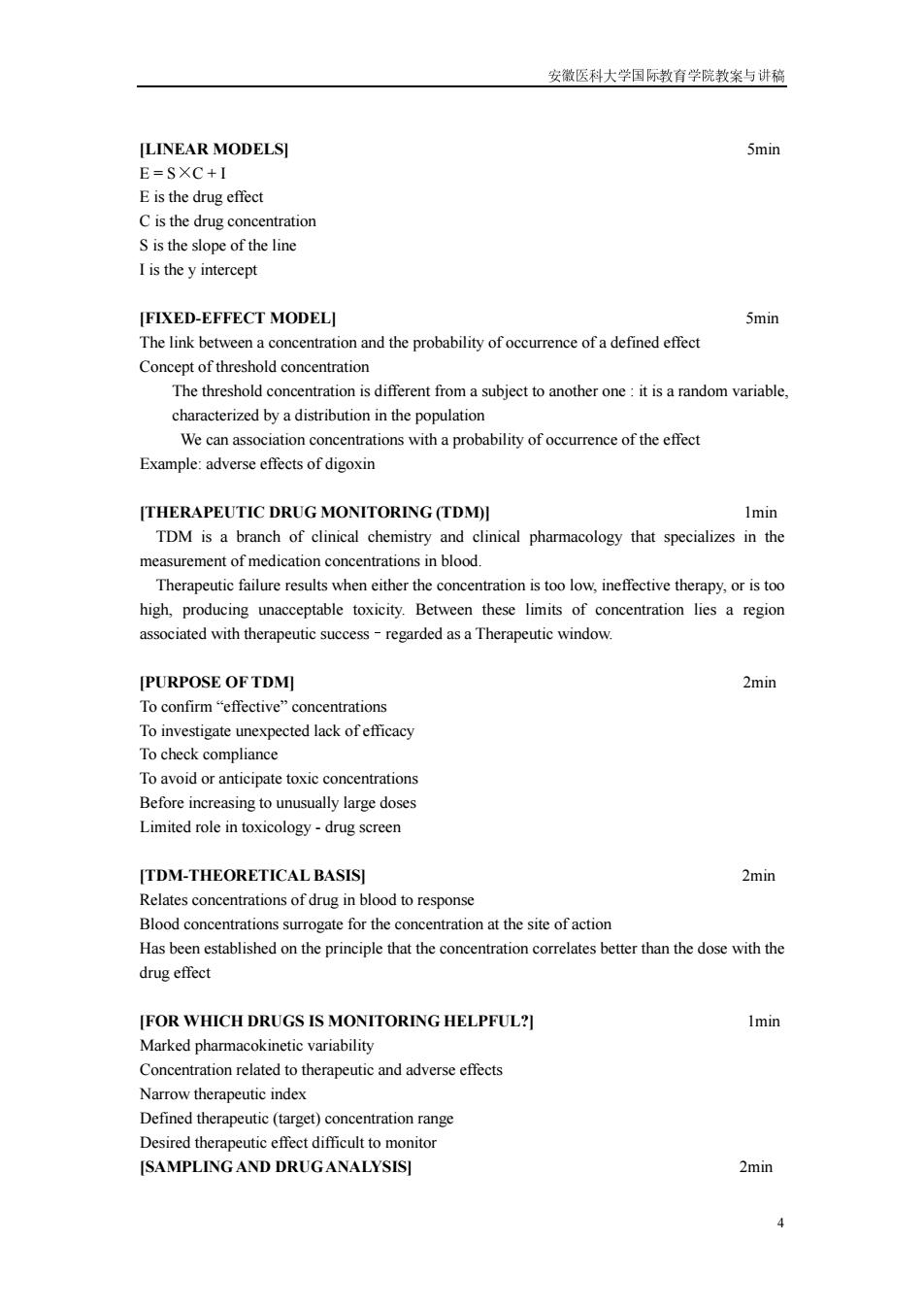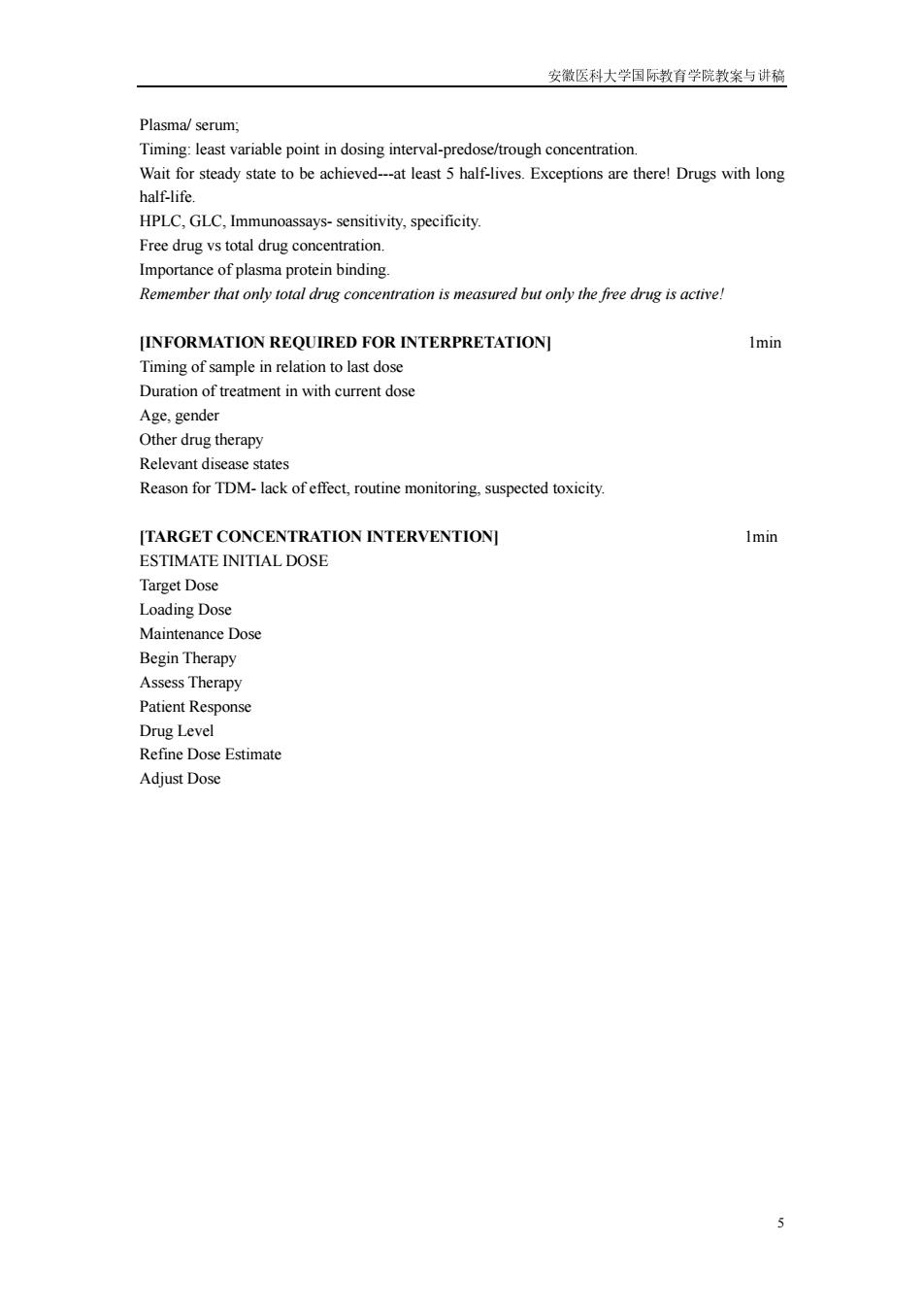
安徽医科大学国际教育学院教案与讲稿 Teaching Plan for International Students,AHMU Title of the course:Dose-effect and concentration-effect analysis Chapter:_ 18 Teacher's name: Dr.Qingtong Wang Grade: 2013 Department:School of International Education Time:14:30-16:50 Date(D/M/Y):3/23/2016 1.Recognize the mechanism of drugs for exerting their pharmacological effects. Teaching 2.Master the dose-effect endpoints(Graded and Quantal),parameters Objectives; Teaching 3.Recognize the major sources relating dose to effect in vivo Requirements 4.Recognize the pharmacodynamic models 5.Master the use of therapeutic drug monitoring(TDM)to target concentration intervention 1.Drug-receptor interaction Teaching 2.Graded/quantal dose-effect relationship Content 3.Pharmacodynamic models 4.The function of TDM in clinical practice Teaching Teaching Focus:Drug-receptor interaction,Graded/quantal dose-effect Focus; relationship,pharmacodynamic models,and the use of TDM Difficult Problems:dose effect and concentration effect analysis,and the Difficult pharmacodynamic models Problems Solutions:Show representative figures to explain the dose-effect relationship and their Solutions and pharmacodynamic models,give examples to introduce the characteristic in detail. 1.Drug-receptor interaction 15min Time 2.Graded/quantal dose-effect relationship 15min Allotment 3.Pharmacodynamic models 20min 4.TDM 10min 1.The definition of dose-effect curve,efficacy,potency. Assignment 2.Use examples to elucidate pharmacodynamic models. 3.What is therapeutic drug monitoring,its purpose and how to TDM? 1.Principle of Clinical Pharmacology(Second Edition);ArthurJ.Atkinson Reference 2.Basic Clinical Pharmacology;Bertram G.Katzung Text 3.Oxford Textbook of Clinical Pharmacology and Drug Therapy;David Grahame-Smith,Jeffrey Aronson Memo 1
安徽医科大学国际教育学院教案与讲稿 1 Teaching Plan for International Students, AHMU Title of the course: Dose-effect and concentration-effect analysis Chapter: 18 Teacher’s name: Dr. Qingtong Wang Grade: 2013 Department: School of International Education Time: 14:30—16:50 Date (D/M/Y): 3/23/2016 Teaching Objectives; Teaching Requirements 1. Recognize the mechanism of drugs for exerting their pharmacological effects. 2. Master the dose-effect endpoints (Graded and Quantal), parameters 3. Recognize the major sources relating dose to effect in vivo 4. Recognize the pharmacodynamic models 5.Master the use of therapeutic drug monitoring (TDM) to target concentration intervention Teaching Content 1. Drug-receptor interaction 2. Graded/ quantal dose-effect relationship 3. Pharmacodynamic models 4. The function of TDM in clinical practice Teaching Focus; Difficult Problems and their Solutions Teaching Focus: Drug-receptor interaction, Graded/ quantal dose-effect relationship, pharmacodynamic models, and the use of TDM Difficult Problems: dose effect and concentration effect analysis, and the pharmacodynamic models Solutions: Show representative figures to explain the dose-effect relationship and pharmacodynamic models, give examples to introduce the characteristic in detail. Time Allotment 1. Drug-receptor interaction 15min 2. Graded/ quantal dose-effect relationship 15min 3. Pharmacodynamic models 20min 4. TDM 10min Assignment 1. The definition of dose-effect curve, efficacy, potency. 2. Use examples to elucidate pharmacodynamic models. 3. What is therapeutic drug monitoring, its purpose and how to TDM? Reference Text 1. Principle of Clinical Pharmacology (Second Edition); ArthurJ. Atkinson 2. Basic & Clinical Pharmacology; Bertram G. Katzung 3.Oxford Textbook of Clinical Pharmacology and Drug Therapy; David Grahame-Smith, Jeffrey Aronson Memo

安徽医科大学国际教育学院教案与讲稿 Teaching Plan for International Students,AHMU Title of the course:Dose-effect and concentration-effect analysis Chapter: 18 Teacher's name: Dr.Qingtong Wang Grade:2013 Department:School of International Education Time:14:30-16:50 Date (D/M/Y): 3/23/2016 Lecture Notes: JINTRODUCTIONI 1 min The intensity and duration of a drug's effects are a function of the drug dose and drug concentration at the effect site [CLASSIFICATION OF DRUGACTION] 4min Receptor mediated Drug action Receptors Ligands (Drugs) Ligand-receptor interaction--effect Non-receptor mediated Drug action Physical property--effect Chemical property--effect DOSE-EFFECT ENDPOINTSI 5min Graded Continuous scale(dose--effect) Measured in a single biologic unit Relates dose to intensity of effect Quantal All-or-none pharmacologic effect Population studies Relates dose to frequency of effect DRUG-RECEPTOR INTERACTIONS] 5min Effect=Maximal effect[Drug] Ko+[Drug] (Kp=k2/k) [DOSE-EFFECT CURVE] 3min Show some representative dose-effect curve and explain,such as:graded dose-effect curve, lidocaine graded dose-effect,theophylline dose-effect,metformin dose-response. [DOSE-EFFECT PARAMETERS] 3min 2
安徽医科大学国际教育学院教案与讲稿 2 Teaching Plan for International Students, AHMU Title of the course: Dose-effect and concentration-effect analysis Chapter: 18 Teacher’s name: Dr. Qingtong Wang Grade: 2013 Department: School of International Education Time: 14:30—16:50 Date (D/M/Y): 3/23/2016 Lecture Notes: [INTRODUCTION] 1 min The intensity and duration of a drug’s effects are a function of the drug dose and drug concentration at the effect site [CLASSIFICATION OF DRUG ACTION] 4min Receptor mediated Drug action Receptors Ligands (Drugs) Ligand-receptor interaction -- effect Non-receptor mediated Drug action Physical property --effect Chemical property -- effect [DOSE-EFFECT ENDPOINTS] 5min Graded Continuous scale (dose--effect) Measured in a single biologic unit Relates dose to intensity of effect Quantal All-or-none pharmacologic effect Population studies Relates dose to frequency of effect [DRUG-RECEPTOR INTERACTIONS] 5min [DOSE-EFFECT CURVE] 3min Show some representative dose-effect curve and explain, such as: graded dose-effect curve, lidocaine graded dose-effect, theophylline dose-effect, metformin dose-response. [DOSE-EFFECT PARAMETERS] 3min

安徽医科大学国际教育学院教案与讲稿 Potency:The sensitivity of an organ or tissue to the drug Efficacy:The maximum effect RELATING DOSE TO EFFECT IN VIVO 4min Dose Effect site =Effect Concentration Pharmacokinetics Pharmacodynamics Age Tissue/organ sensitivity Absorption (receptor status) Distribution Elimination Drug interactions [MAJOR SOURCES OF VARIABILITY] 5min Compliance Age-neonates,children,elderly Physiology-gender,pregnancy Disease-Hepatic,renal,cardiovascular,respiratory Drug interactions Environmental influences on drug metabolism Genetic polymorphisms [PHARMACODYNAMIC MODELS] 2min Relation between concentration and the intensity of an effect The Emax and Sigmoid Emax Models Linear Models Relation between concentration and probability of occurrence of an effect Fixed-effect model [THE EMAX AND SIGMOID EMAX MODELS] 3min Models describing relations between intensity of an effect and drug concentrations at the site of action Can be used inin vivo PK/PD modelling when there exist a direct and immediate link between plasma concentrations and effect EMAX MODELI 5min Relation described by two parameters Emax:intrinsic activity,EFFICACY EC50:conc.Associated with half-maximal effect,POTENCY Empirical justifications The most simple mathematical description of the occurrence of a maximum effect Theoretical justifications Ligand-receptor interaction 3
安徽医科大学国际教育学院教案与讲稿 3 Potency: The sensitivity of an organ or tissue to the drug Efficacy: The maximum effect [RELATING DOSE TO EFFECT IN VIVO] 4min [MAJOR SOURCES OF VARIABILITY] 5min Compliance Age- neonates, children, elderly Physiology- gender, pregnancy Disease- Hepatic, renal, cardiovascular, respiratory Drug interactions Environmental influences on drug metabolism Genetic polymorphisms [PHARMACODYNAMIC MODELS] 2min Relation between concentration and the intensity of an effect The Emax and Sigmoid Emax Models Linear Models Relation between concentration and probability of occurrence of an effect Fixed-effect model [THE EMAX AND SIGMOID EMAX MODELS] 3min Models describing relations between intensity of an effect and drug concentrations at the site of action Can be used in in vivo PK/PD modelling when there exist a direct and immediate link between plasma concentrations and effect [EMAX MODEL] 5min Relation described by two parameters Emax: intrinsic activity, EFFICACY EC50: conc. Associated with half-maximal effect, POTENCY Empirical justifications The most simple mathematical description of the occurrence of a maximum effect Theoretical justifications Ligand-receptor interaction

安徽医科大学国际教育学院教案与讲稿 LINEAR MODELS] 5min E=SXC+I E is the drug effect C is the drug concentration S is the slope of the line I is the y intercept FIXED-EFFECT MODELI 5min The link between a concentration and the probability of occurrence of a defined effect Concept of threshold concentration The threshold concentration is different from a subject to another one:it is a random variable, characterized by a distribution in the population We can association concentrations with a probability of occurrence of the effect Example:adverse effects of digoxin THERAPEUTIC DRUG MONITORING(TDM)I lmin TDM is a branch of clinical chemistry and clinical pharmacology that specializes in the measurement of medication concentrations in blood. Therapeutic failure results when either the concentration is too low,ineffective therapy,or is too high,producing unacceptable toxicity.Between these limits of concentration lies a region associated with therapeutic success-regarded as a Therapeutic window. [PURPOSE OF TDM] 2min To confirm“effective'”concentrations To investigate unexpected lack of efficacy To check compliance To avoid or anticipate toxic concentrations Before increasing to unusually large doses Limited role in toxicology-drug screen ITDM-THEORETICAL BASISI 2min Relates concentrations of drug in blood to response Blood concentrations surrogate for the concentration at the site of action Has been established on the principle that the concentration correlates better than the dose with the drug effect [FOR WHICH DRUGS IS MONITORING HELPFUL?] 1min Marked pharmacokinetic variability Concentration related to therapeutic and adverse effects Narrow therapeutic index Defined therapeutic (target)concentration range Desired therapeutic effect difficult to monitor [SAMPLING AND DRUGANALYSISI 2min 4
安徽医科大学国际教育学院教案与讲稿 4 [LINEAR MODELS] 5min E = S×C + I E is the drug effect C is the drug concentration S is the slope of the line I is the y intercept [FIXED-EFFECT MODEL] 5min The link between a concentration and the probability of occurrence of a defined effect Concept of threshold concentration The threshold concentration is different from a subject to another one : it is a random variable, characterized by a distribution in the population We can association concentrations with a probability of occurrence of the effect Example: adverse effects of digoxin [THERAPEUTIC DRUG MONITORING (TDM)] 1min TDM is a branch of clinical chemistry and clinical pharmacology that specializes in the measurement of medication concentrations in blood. Therapeutic failure results when either the concentration is too low, ineffective therapy, or is too high, producing unacceptable toxicity. Between these limits of concentration lies a region associated with therapeutic success–regarded as a Therapeutic window. [PURPOSE OF TDM] 2min To confirm “effective” concentrations To investigate unexpected lack of efficacy To check compliance To avoid or anticipate toxic concentrations Before increasing to unusually large doses Limited role in toxicology - drug screen [TDM-THEORETICAL BASIS] 2min Relates concentrations of drug in blood to response Blood concentrations surrogate for the concentration at the site of action Has been established on the principle that the concentration correlates better than the dose with the drug effect [FOR WHICH DRUGS IS MONITORING HELPFUL?] 1min Marked pharmacokinetic variability Concentration related to therapeutic and adverse effects Narrow therapeutic index Defined therapeutic (target) concentration range Desired therapeutic effect difficult to monitor [SAMPLING AND DRUG ANALYSIS] 2min

安徽医科大学国际教育学院教案与讲稿 Plasma/serum; Timing:least variable point in dosing interval-predose/trough concentration. Wait for steady state to be achieved---at least 5 half-lives.Exceptions are there!Drugs with long half-life. HPLC,GLC,Immunoassays-sensitivity,specificity. Free drug vs total drug concentration. Importance of plasma protein binding. Remember that only total drug concentration is measured but only the free drug is active! JINFORMATION REQUIRED FOR INTERPRETATIONI 1min Timing of sample in relation to last dose Duration of treatment in with current dose Age,gender Other drug therapy Relevant disease states Reason for TDM-lack of effect,routine monitoring,suspected toxicity. [TARGET CONCENTRATION INTERVENTIONJ lmin ESTIMATE INITIAL DOSE Target Dose Loading Dose Maintenance Dose Begin Therapy Assess Therapy Patient Response Drug Level Refine Dose Estimate Adjust Dose 5
安徽医科大学国际教育学院教案与讲稿 5 Plasma/ serum; Timing: least variable point in dosing interval-predose/trough concentration. Wait for steady state to be achieved---at least 5 half-lives. Exceptions are there! Drugs with long half-life. HPLC, GLC, Immunoassays- sensitivity, specificity. Free drug vs total drug concentration. Importance of plasma protein binding. Remember that only total drug concentration is measured but only the free drug is active! [INFORMATION REQUIRED FOR INTERPRETATION] 1min Timing of sample in relation to last dose Duration of treatment in with current dose Age, gender Other drug therapy Relevant disease states Reason for TDM- lack of effect, routine monitoring, suspected toxicity. [TARGET CONCENTRATION INTERVENTION] 1min ESTIMATE INITIAL DOSE Target Dose Loading Dose Maintenance Dose Begin Therapy Assess Therapy Patient Response Drug Level Refine Dose Estimate Adjust Dose